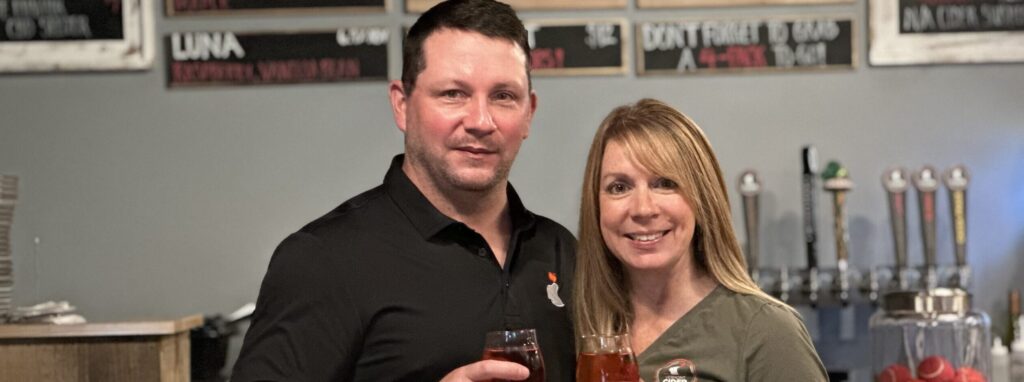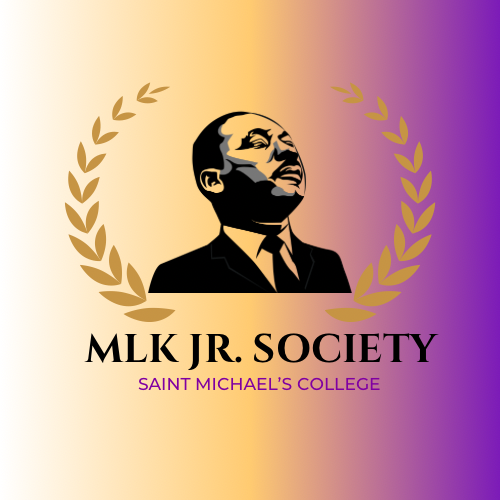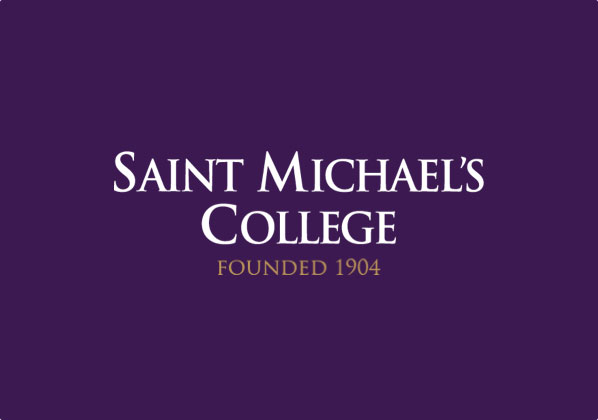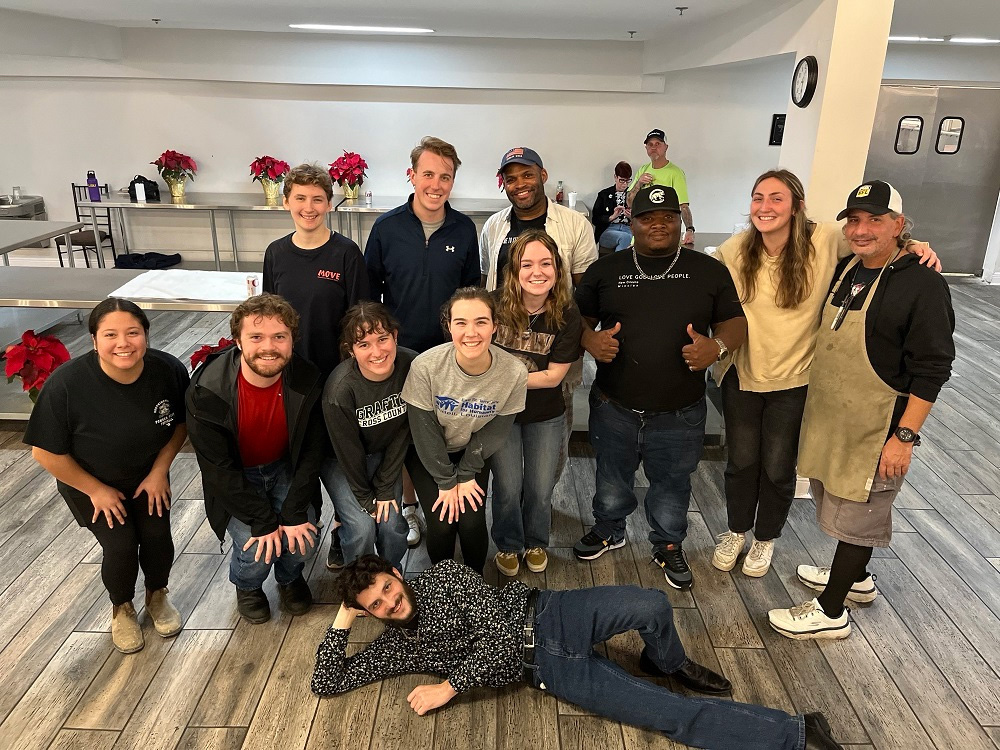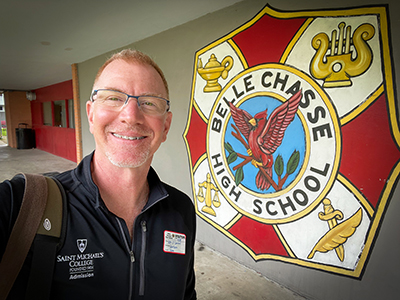Summer researchers to mentors: What’s next?
Tables turned on Saint Michael’s College faculty mentors for the third and final summer research lunch in Dion Family Student Center on Tuesday, July 14, as their student understudies had a chance to question professors about how the projects they’ve been collaborating on for many weeks might bear on the younger scholars’ futures.
Karen Talentino, vice president for academic affairs, whose office sponsors three such lunches over the summer to share outcomes and build community among the approximately 50 students and their mentors, asked them to “reflect on what you’ve accomplished and learned and what this might mean longer-term — and ask your mentors about it.” She also invited each student to share at individual tables a two-minute “elevator speech” that sums up in precise and understandable language their research, should anybody ask about it.
A group of aspiring biologists studying water quality and macro-invertebrates (bugs) in Vermont waterways through funds from Vermont EPSCoR (Experimental Program to Stimulate Competitive Research) told about how they hedge their bets against weather surprises in order to assure data. If it rains, it’s great for taking water samples, and if it doesn’t, it’s great for collecting bugs, said Janel Roberge’12, a technician hired by Vermont EPSCoR to run the water quality lab and supervise students. As a former “bug intern” in her student days, she’s an example of paths before the younger researchers. Now she works on campus year-round for the Center for Workforce Development and Diversity within EPSCoR, recruiting students of all backgrounds from near and far. A student said abundant rain put their group of seven behind their timetable, but the data still will be collected and the work completed before waterways freeze, since the labs under biology Chair Declan McCabe continue year-round, even if with other students.
Adam Weaver of biology was asked by his student, Bryanna Evoy’16 of Morrisonville, NY, how he came to focus his work on the nervous systems of leeches — of all things. He told the story of starting in psychology as an undergraduate before moving toward mathematical modeling of the brain which involved studies on simple pattern generators in brains that inform walking, breathing and digestion. “I ended up studying digestion in lobsters and somehow got from lobsters to leeches and ended up there,” he said.
Charles D.V. Poston ’16 of Fitzwilliam, NH, working with biology’s Mac Lippert on yeast genetic mutations, asked Lippert about his biggest challenge as an undergrad researcher. It was “getting the research organisms I needed to do the work,” Lippert said. He worked for months but never got his early experiment to work, “which might have dampened doing research for me you’d think, but I had other successes and realized it’s really a part of doing research – trouble-shooting and getting around challenges. Sometimes the question you want to ask isn’t ready to be answered.”
At the next table, education’s Valerie Bang-Jensen’s chief advice in response to a student question was to be sure “to shape your question well and take the time you need” to get to the desired destination. Laura Stroup, environmental studies professor at the same table, added that invariably, projects “always take more time than you plan for. You always expect you’re going to finish more than you will.”
Rahela Mohammad Akbar’16 of Kabul, Afghanistan was direct in her question to Liz Inness-Brown, who is guiding Akbar in writing an original novel based on personal experiences. “What do you think about my book, and do you think people might be interested to buy it?” she asked. Inness-Brown said she found the book “fascinating” so far. “I’m enjoying it a great deal — you’ve got a good story to tell and are very good at developing characters and scenes and using dialogue.” Since she’s enjoying it she feels others will too, the professor said, adding that in her own writing, she’s on the 10th draft or so of her latest work, so it won’t necessarily be easy.
Felipe Stanislau Candido, a Brazilian student doing science research with Shane Lamos of the Chemistry Department, heard praise from his mentor for the great progress he’s made on English. Lamos says he loves having international students in his lab. “It’s fun to learn cross-cultural things – like we went hiking and learned that in Brazil you don’t go into the jungle because it’s dangerous, not something you do for fun.” International students are usually motivated and resourceful which is what got them to the U.S. in the first place, and working with them “is grand, I really enjoy it,” said Lamos.
Faculty biologist Paul Constantino ’92 had a group working on tooth structure in mammals. His charges wondered aloud about the impact of their work on humans, but Constantino said “I don’t think all research has to have a human component or human relevance.” Yet their work this summer still might contribute to understanding dietary issues and evolutionary history, “not just of humans, but all animals,” he said.
Nicole Corneau ’17 of Ashaway, RI, asked her mentor Jonathan Silverman, education, what he thinks might cause teachers to resist adapting the manual she is working on for teaching about sustainability in environmental education. He said that among teachers, “the threat is to stay stuck in their own paradigm, so they’re less willing to step outside their traditional way of teaching. What you’re proposing leads to ambiguity, and taking students outside would challenge them. Might they get hurt? And what if they don’t get along?”
One of Professor David Heroux’s chemistry researchers challenged him to deliver his “elevator speech” since it was said to be so important for students. Heroux fairly dazzled the assembly with a clear and concise roundup of his very complex chemistry work … ending with the fun fact that catalysis of the type he’s involved with (interacting molecules and surfaces to make cheaper materials better and more valuable) is responsible for about a third of the world’s Gross Domestic Product.
The group working on nanostructures with Professor Greta Pangborn asked about the prospects for future funding to continue their important work. Pangborn says she and collaborator Jo Ellis-Monaghan of mathematics have monthly conference calls with chemists at Cal Tech when they try to understand chemistry problems well enough to create useful models. And they’re hopeful and optimistic the next ones will lead to more good summer problems, she said, since funding depends on that for them.
The last question put to young faculty biologist Dagan Loisel was how he decided to become a professor at a college like Saint Michael’s. He talked about his post-doc work at University of Chicago in human genetics, when he realized “I didn’t want to devote my entire life to asking research questions alone.” He thought of how he liked things he did as an undergraduate with the rewarding mentoring dynamic at a New England liberal arts college, and felt he could do that and still ask important research questions that interested him. “That’s what a school like Saint Michael’s gives you,” he said, adding that meeting students in his Saint Michael’s interview sealed the deal for him. “The students asked great questions, and I could see great opportunities to grow as an educator and have a good work/life balance.”
